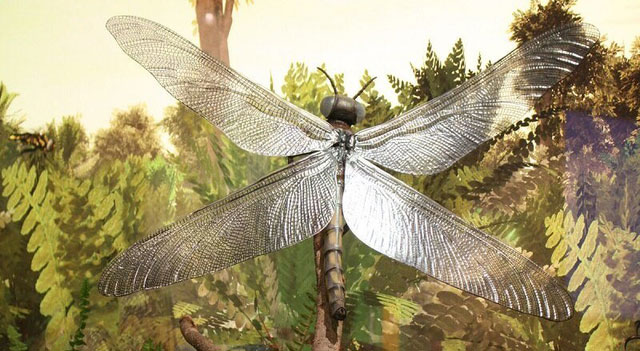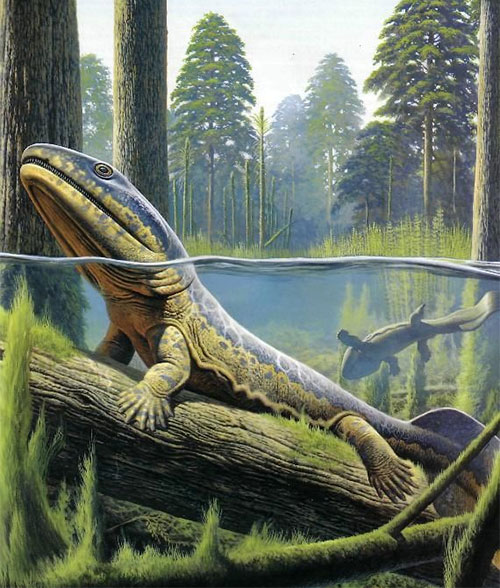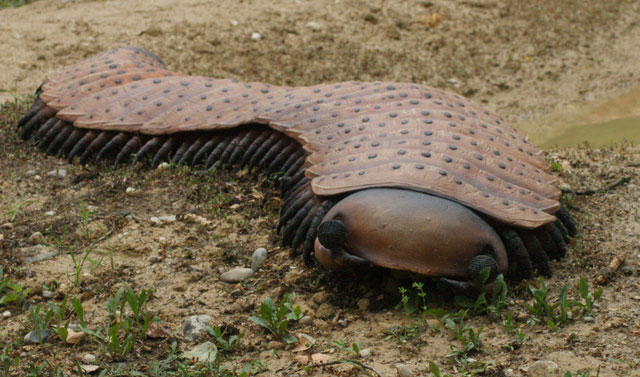Giant dragonflies and facts about the prehistoric world that you should know
No matter how cute or small the animals today are, in them in the Mesozoic era they looked extremely scary, giant. So let's review some of the facts revolving around the prehistoric world.
Facts about prehistoric creatures
- 1. Giant insects, giant mice, giant fish, everything is giant
- 2. Why do prehistoric fish have toes?
- 3. Are there animals with thousands of legs?
- 4. Reptiles originated from amphibians
- 5. Early amphibians did not seem like frogs
1. Giant insects, giant mice, giant fish, everything is giant
That is the truth. In a time when dinosaurs didn't appear, having insects or pretty little animals at a giant size was . normal. The most famous is probably the giant dragonfly Meganeura - the ancestor of today's dragonfly, extinct from the Carbon period about 300 million years ago.

Giant dragonfly Meganeura - ancestor of today's dragonflies.
Basically, the dragonfly Meganeura deserves the name of the largest flying insect of all time that humans have known. Its wingspan is 70 centimeters long and is thought to be equivalent to the wingspan of a small-sized bird. When they fly, their wings are humming, making other animals feel extremely uncomfortable. However, it is also quite fortunate that this giant dragonfly eats only insects.
In that era, the ancient mouse Phoberomys pattersoni was about the size of a cow; Beelzebufo prehistoric frog is almost half a meter long, weighs about 4 kg; Megapiranha - ancient piranhas are about the size of a skateboard, . In general, the small sized animals we know today can all have their ancestors in super-sized size.

Megapiranha has a monstrous shape, much more terrifying than modern piranhas.

Megapiranha has appeared in movies.
2. Why do prehistoric fish have toes?
Why prehistoric fish have toes? Of course it's gone, and no matter how many opinions they make, they gain the most scientific trust, about being the ancestors of the following mammals, reptiles and amphibians. this.
About 370 million years ago in the late Devonian period (the Famenne layer) , the Acanthostega vertebrates fish appeared. Unlike other fish, it has 4 legs instead of fins, each leg has 8 toes, and is technically this species is located between the lobe fin fish with animals that have all parts moving on land.

Acanthostega has many characteristics like amphibians in the first period.
The most famous is the Ichthyostega, which appeared 365 million years ago, has seven fingers and is considered the first animal to walk on land.
3. Are there animals with thousands of legs?
It sounds terrible, right? But that is quite normal. 250 million years ago, many legged animals had thousands of legs. The largest of them is the Arthropleura, which is 2 meters long and became extinct 280 million years ago.

Restoration model of Arthropleura.
4. Reptiles originated from amphibians
About 350 million years ago, some amphibians placed scales on their bodies to protect themselves from the sun, so as not to dry up on land. Their eggs are no longer soft eggs, but also have an outer shell to let air through and retain the amount of water needed for the embryo inside. Those are some of the characteristics of later reptiles.
5. Early amphibians did not seem like frogs
As mentioned above, early amphibians were descendants of 4-legged fish. So, they have long legs, short legs and long tails - traces of the previous caudal fins. In short, they look more like lizards and crocodiles than frogs.

Eryops species are more like crocodiles and lizards than the modern amphibians.
The most prominent is the Eryops species that appeared about 300 million years ago, up to 2m long, long snout, many sharp teeth.
- The prehistoric insects that make you
- Discover the largest, most crude dragonfly in the world
- The 10 facts about the
- Startled with the 'monster' dragonfly more than 20cm long
- Dragonflies also have the ability to focus like humans
- 3 giant prehistoric monsters can exist today
- Monsters that dominated the prehistoric world
- Strange creatures that look like 'giant dragonflies' attract thousands of viewers
- The dragonfly will die to avoid being bullied by the male
- Causes turn dragonflies from gold to red
- Giant fossils and the fear of prehistoric creatures
- Ancient giant pig: Terror of prehistoric North America
 Discovered an ancient centipede fossil 99 million years old
Discovered an ancient centipede fossil 99 million years old Discovered bat-like dinosaurs in China
Discovered bat-like dinosaurs in China Discovered a 200-year-old bronze cannon of the coast
Discovered a 200-year-old bronze cannon of the coast Discover 305 million-year-old spider fossils
Discover 305 million-year-old spider fossils What was Earth like in the age of giant insects?
What was Earth like in the age of giant insects?  Video: Fishermen caught a giant fish weighing 150kg on the Mekong River
Video: Fishermen caught a giant fish weighing 150kg on the Mekong River  'Strange mushroom-shaped object' is rising, splitting an Earth continent in two
'Strange mushroom-shaped object' is rising, splitting an Earth continent in two  New discovery in Antarctica: Scientists find mysterious 'giant object' with a diameter of 56km!
New discovery in Antarctica: Scientists find mysterious 'giant object' with a diameter of 56km!  What if ants were the size of elephants?
What if ants were the size of elephants?  Surprised by the animal that looks holy but makes crocodiles and leopards run away when they meet
Surprised by the animal that looks holy but makes crocodiles and leopards run away when they meet 